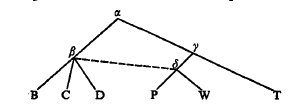No CrossRef data available.
Published online by Cambridge University Press: 11 February 2009
Since the appearance of Dodds's edition of Gorgias a number of the dialogues in tetr. I-VII have benefited from a re-examination of the evidence for the Platonic text—most notably Meno, tetr. IV, Parmenides, and Phaedrus. Recently the textual tradition of Phaedo has been studied by A. Carlini in a useful book which traces the fortunes of the text from antiquity until the time of the major manuscripts. The evidence thus accumulated goes some way to lessening a problem which has long been obvious—the difficulty of studying the tradition of any single dialogue in isolation from the rest of the Platonic corpus. I propose to argue, however, that the bulk of evidence now available for several dialogues should not blind us to another hazard—that of attempting to fit dialogues showing different textual features into what is basically a single stemmatic pattern
page 41 note 2 Plato, Gorgias, ed. E. R. Dodds (Oxford, 1959).
page 41 note 3 Carlini, A., Studi sulla tradizione antica e medievale del Fedone (Rome, 1972).Google Scholar
page 41 note 4 Platone, Alcibiade, Alcibiade secondo, Ip. parco, Rivali ed. Carlini, A. (Turin, 1964), 24.Google Scholar
page 41 note 5 Studi, 170–1.
page 41 note 6 Ibid., 138: ‘Questa convergenza per contaminazione può essere responsabile, secondo me, in alcuni casi addirittura dell'oscuramento dei reali rapporti fra i tre rami tradizionali …’
page 41 note 7 This scheme, of course, omits lines of contamination.
page 42 note 1 Studi, 138 n. 35: ‘L'analisi fatta allora [i.e. in his edition of tetr. IV] va rivista alla lute delle nuove acquisizioni.’
page 42 note 2 e.g. Laur. 85. 12, Laur. 89. 78, Ambros. 238 (in which the change occurs in the middle of a dialogue). Obviously such a ‘source-change’ could occur for a number of different reasons. A ‘composite’ manuscript in which dialogues are copied by different hands from different exemplars will produce offspring which are indistinguishable from manuscripts in which a single scribe has deliberately changed sources in the course of his work.
page 42 note 3 R. Hensel, Vindiciae Platonicae (Berlin, 906)
page 42 note 4 I have collated W from photographs. In addition I have collated T and D from the original manuscripts. Since B and D are very closely related I regard their consensus as representing the reading of the first family. In lists of B discrepancies as against T (or W) it can be assumed that D either agrees with B or does not offer a reading which may lead one to suspect that B has distorted a first family reading which is actually the same as that of T (or W). Usually when B and D disagree it is plain that D has bungled. I ignore P. Its scanty Politicus excerpts are of little interest. C is not extant for Politicus.
page 42 note 5 Exact figures are not possible. In what follows I ignore orthographical variants, differences over breathings, accentuation, punctuation, speaker division, presence or absence of v ephelkustikon. Errors of word division are also normally ignored. When the vertical reading of a tradition is doubtful through the presence in a manuscript of alternative readings or corrections which may be the work of the first hand, the evidence of the manuscript is normally ignored at that point. Such instances are, in any case, not sufficiently numerous to weaken the force of the calculations to any significant extent.
page 43 note 1
270 e 4  Te TW is a shared error However, t reads
Te TW is a shared error However, t reads  and it is a variant in WA (perhaps by m. 1). At 268 a 6 editors reject
and it is a variant in WA (perhaps by m. 1). At 268 a 6 editors reject  of TW for
of TW for  BD TW are not, however, manifestly wrong. At 284 b I
BD TW are not, however, manifestly wrong. At 284 b I  TW, if it is wrong. would be an easy coincidence. At 287 c 8 8
TW, if it is wrong. would be an easy coincidence. At 287 c 8 8  which is not in any primary manuscript is probably right and this would explain B's
which is not in any primary manuscript is probably right and this would explain B's  . However,
. However,  could easily be a ‘correction’ of archetypal
could easily be a ‘correction’ of archetypal  by T and W independently.
by T and W independently.
page 44 note 1 I exclude special cases such as myth which might be read independently of the dialogues which contain them.
page 44 note 2 Another possibility would be to suppose access to a defective manuscript which only contained Pol. 287-end.
page 44 note 3 A contaminator obtaining a new manu script under such circumstances would of course theoretically be able to revise what he had already copied (or read) by adding lections in the margin for the earlier part of the dialogue also. Only by supposing access to a defective manuscript can this possibility be excluded.
page 45 note 1 The same argument is of course valid against the view that W changes completely to a T-related source.
page 46 note 1
258 a 2  W: BDT is a solitary—and by no means certain—possible uncial error shared by BDT against W in section I.
W: BDT is a solitary—and by no means certain—possible uncial error shared by BDT against W in section I.
page 47 note 1
At 292 c 3 W offers  , though apparently post con. B has
, though apparently post con. B has  , while T offers
, while T offers  . In T, however, the v is marked for deletion. At 307 d 2 W post corr. is alone in offering
. In T, however, the v is marked for deletion. At 307 d 2 W post corr. is alone in offering  against BDTW ante corr. However, the author of the correction does not seem to have been the original scribe.
against BDTW ante corr. However, the author of the correction does not seem to have been the original scribe.
page 47 note 2 Meno, ed. Bluck, R. S. (Cambridge, 1961), 135.Google Scholar